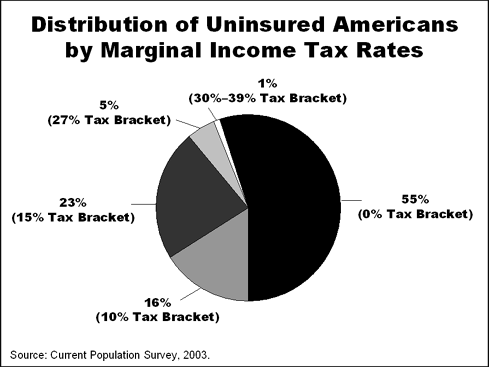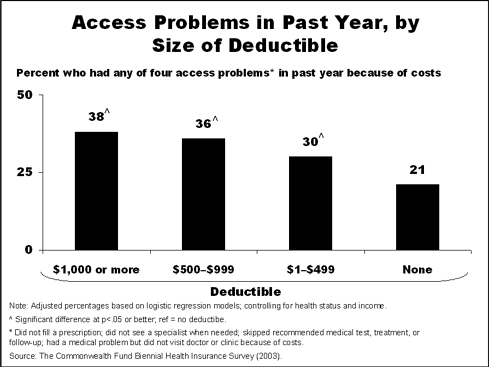Researchers Say Accounts Could Destabilize Insurance Market for Small Employers
Low and Middle-Income Uninsured Will See Little or No Tax Savings from HSAs
New York City, April 20, 2005—Fewer than 1 million of the nation's 45 million uninsured are likely to get new health coverage as a result of Health Savings Accounts (HSAs) coupled with high-deductible health plans, says a new report by researchers Sherry Glied and Dahlia Remler of Columbia University. HSAs could also lead to destabilization in the group health insurance market if small businesses begin to offer only high-deductible plans because their higher-wage employees prefer them, says the report, The Effect of Health Savings Accounts on Health Insurance Coverage, based on research supported by The Commonwealth Fund.
Glied and Remler estimate that more than one-half of uninsured adults currently owe no income taxes, which is why tax incentives for high-deductible health plans would have little impact on coverage among the uninsured. Uninsured individuals in the middle income tax bracket would potentially realize savings representing just 3% to 6% of a typical high-deductible's annual premium of $2,000. Consequently, few uninsured individuals would be likely to enroll in HSAs with high-deductible plans.

"Very few people will gain insurance coverage because of tax preferences for Health Savings Accounts, and in fact some people may lose coverage," says Glied, Professor in the Department of Health Policy and Management of Columbia's Mailman School of Public Health. "Lower-wage workers in small firms are likely to be most at risk for dropping coverage if they are only offered a plan that provides little protection for out-of-pocket costs."
The authors estimate that take-up rates of high-deductible plans at this level of savings would be about 0.3 percent of the current adult uninsured population, or less than 100,000 people; even their most generous assumption would increase the number of newly insured by less than 2 percent. Their estimates are based on similar analyses assuming that every 10 percent decrease in the price of standard health insurance policies leads about 6 percent of uninsured people to take up coverage.
The more likely effect of HSAs would be to encourage individuals who already have insurance to switch the form of their coverage. The authors warn that lower-income employees could be worse off if employers—particularly small businesses who are more likely to offer only one plan—shift toward high-deductible plans because of the preference of their higher-income employees for HSAs. Lower-income employees left with only the choice of a high-deductible plan would not be able to reap tax benefits or save enough to cover out-of-pocket expenses, and some may opt to drop coverage altogether.
In a companion report released today,
How High Is Too High? Implications of High-Deductible Health Plans Fund President Karen Davis and colleagues conclude that providing tax incentives for the purchase of high-deductible health plans will not have the effect of increasing health care coverage because these plans are not likely to be affordable for the majority of the uninsured.
The authors note that premiums for high-deductible plans range from 6% to 20% of income for individuals with incomes up to 200% of the federal poverty level. Low-income families would be at risk for spending a high proportion of income—up to 30%—on out-of-pocket costs with high-deductible health plans. Two–thirds of the uninsured have incomes below 200 percent of the federal poverty level.

High-deductible plans could also have the effect of reducing access to needed medical care and increasing medical debt problems, the authors say. Findings from The Commonwealth Fund Biennial Health Insurance Survey (2003) reveal that more than one-third of individuals with deductibles of $1,000 or more experience barriers to access to health care due to cost—including not filling a prescription, not seeing a doctor or specialist when needed, or skipping a recommended test or medical treatment—compared to one-fifth (21%) of those with no deductibles, when controlling for health status and income. More than half of adults with deductibles over $1,000 experience medical bill or debt problems, compared with one-quarter of those with no deductibles, controlling for health status and income.
The authors note that the major effect of a high-deductible is likely to be a one-time shift in spending from premiums to out-of-pocket outlays by patients. While premiums would be reduced by 10–15 percent, most of that would be accounted for by a reduction in covered medical costs, leaving enrollees responsible for additional out-of-pocket expenses. Further, in a market where premiums are rising 12–15 percent a year, employers and employees could expect to see an increase in subsequent years.
The authors say the HSA legislation could be improved to help target the uninsured for coverage, and to ensure access to care for lower-income individuals. They suggest several policy options to achieve these goals, including:
- Permit employers to lower deductibles for low-wage workers; qualify plans with deductibles less than a certain percentage of income (2%, for example).
- Exempt primary as well as preventive care from deductible so they can be covered in full.
- Ensure that workers covered by employer plans have a choice of a comprehensive health plan.
- Permit greater flexibility in benefit design.
- Set an income ceiling on HSAs to reduce subsidies for higher-income individuals.
"The potentially harmful impact of high-deductibles on access to needed care and increased medical bill and medical debt problems of even insured individuals raises a serious question as to the advisability of the move toward such plans," the authors say.




